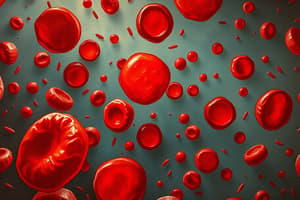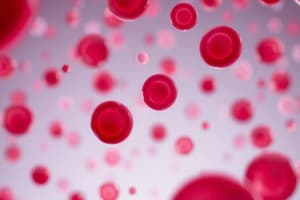Podcast
Questions and Answers
What is the primary function of red blood cells?
What is the primary function of red blood cells?
- Form clots to prevent blood loss
- Collect waste products for excretion
- Transport oxygen from the lungs to body cells (correct)
- Fight disease and infections
Which component of blood is primarily responsible for fighting infections?
Which component of blood is primarily responsible for fighting infections?
- Plasma
- Platelets
- Red blood cells
- White blood cells (correct)
What is the function of platelets in the blood?
What is the function of platelets in the blood?
- Carry carbon dioxide from cells to the lungs
- Produce hormones needed for growth
- Block the flow of blood and form clots (correct)
- Transport oxygen to body organs
What constitutes the majority of blood, making up about 55% of its composition?
What constitutes the majority of blood, making up about 55% of its composition?
How many red blood cells are there approximately for every white blood cell in the bloodstream?
How many red blood cells are there approximately for every white blood cell in the bloodstream?
What percentage of a drop of blood is made up of cells?
What percentage of a drop of blood is made up of cells?
Which of the following is NOT a component of blood?
Which of the following is NOT a component of blood?
What role do white blood cells play when there is a wound?
What role do white blood cells play when there is a wound?
What allows blood to carry significantly more oxygen than water?
What allows blood to carry significantly more oxygen than water?
What do platelets primarily do at the site of a wound?
What do platelets primarily do at the site of a wound?
Which of the following is a waste product found in plasma?
Which of the following is a waste product found in plasma?
What is the primary characteristic of plasma in blood?
What is the primary characteristic of plasma in blood?
How are white blood cells related to pus at a wound site?
How are white blood cells related to pus at a wound site?
Study Notes
Components of Blood
- Blood consists of red cells, white cells, platelets, and plasma.
- Approximately 45% of blood volume is made up of cells.
Red Blood Cells (RBCs)
- Contain hemoglobin, which is crucial for oxygen transport.
- Transports oxygen from lungs to body cells efficiently.
- Capable of carrying 100 times more oxygen than an equal volume of water.
- There are 500 red blood cells for every white blood cell.
White Blood Cells (WBCs)
- Essential for the immune response; fight disease and infections.
- Attack bacteria and produce chemicals to combat viruses.
- Accumulate at wound sites, where they consume invading bacteria.
- WBCs die in the process of fighting infections, contributing to pus formation.
Platelets
- Small fragments of cells that play a crucial role in blood clotting.
- Gather at capillaries where a wound occurs, blocking blood flow.
- Form clots that prevent blood loss from the site of injury.
Plasma
- Comprises about 55% of blood and is a yellowish liquid.
- Contains digested nutrients, hormones, urea (a waste product), and carbon dioxide.
- Serves as a medium for transporting various substances throughout the body.
Components of Blood
- Blood consists of red cells, white cells, platelets, and plasma.
- Approximately 45% of blood volume is made up of cells.
Red Blood Cells (RBCs)
- Contain hemoglobin, which is crucial for oxygen transport.
- Transports oxygen from lungs to body cells efficiently.
- Capable of carrying 100 times more oxygen than an equal volume of water.
- There are 500 red blood cells for every white blood cell.
White Blood Cells (WBCs)
- Essential for the immune response; fight disease and infections.
- Attack bacteria and produce chemicals to combat viruses.
- Accumulate at wound sites, where they consume invading bacteria.
- WBCs die in the process of fighting infections, contributing to pus formation.
Platelets
- Small fragments of cells that play a crucial role in blood clotting.
- Gather at capillaries where a wound occurs, blocking blood flow.
- Form clots that prevent blood loss from the site of injury.
Plasma
- Comprises about 55% of blood and is a yellowish liquid.
- Contains digested nutrients, hormones, urea (a waste product), and carbon dioxide.
- Serves as a medium for transporting various substances throughout the body.
Studying That Suits You
Use AI to generate personalized quizzes and flashcards to suit your learning preferences.
Description
Explore the fascinating components of blood in this quiz covering Chapter 1. Learn about red cells, white cells, platelets, and plasma, as well as their roles and significance in the human body. Test your knowledge and discover how these elements work together to sustain life.




